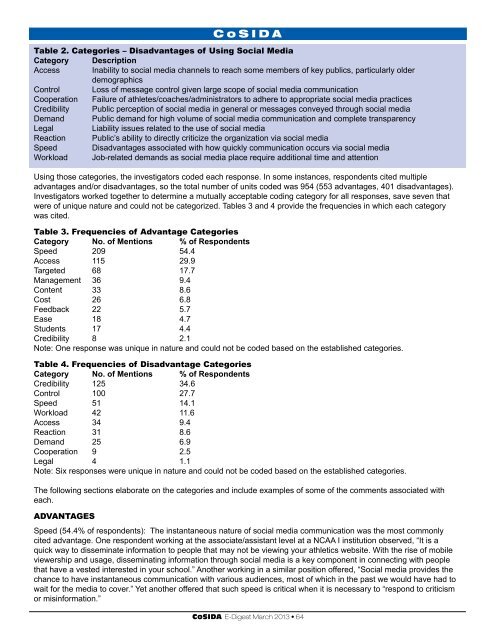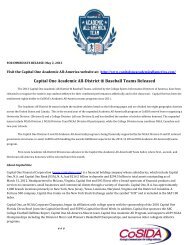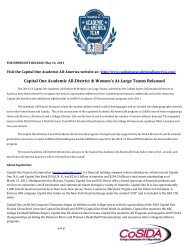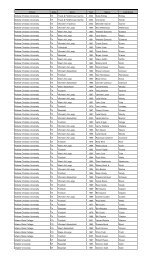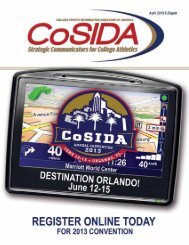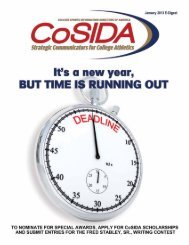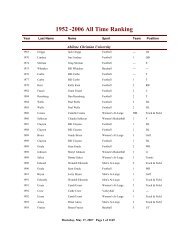CoSIDA E-Digest March 2013 • 1
CoSIDA E-Digest March 2013 • 1
CoSIDA E-Digest March 2013 • 1
Create successful ePaper yourself
Turn your PDF publications into a flip-book with our unique Google optimized e-Paper software.
<strong>CoSIDA</strong><br />
Table 2. Categories – Disadvantages of Using Social Media<br />
Category Description<br />
Access Inability to social media channels to reach some members of key publics, particularly older<br />
demographics<br />
Control Loss of message control given large scope of social media communication<br />
Cooperation Failure of athletes/coaches/administrators to adhere to appropriate social media practices<br />
Credibility Public perception of social media in general or messages conveyed through social media<br />
Demand Public demand for high volume of social media communication and complete transparency<br />
Legal Liability issues related to the use of social media<br />
Reaction Public’s ability to directly criticize the organization via social media<br />
Speed Disadvantages associated with how quickly communication occurs via social media<br />
Workload Job-related demands as social media place require additional time and attention<br />
Using those categories, the investigators coded each response. In some instances, respondents cited multiple<br />
advantages and/or disadvantages, so the total number of units coded was 954 (553 advantages, 401 disadvantages).<br />
Investigators worked together to determine a mutually acceptable coding category for all responses, save seven that<br />
were of unique nature and could not be categorized. Tables 3 and 4 provide the frequencies in which each category<br />
was cited.<br />
Table 3. Frequencies of Advantage Categories<br />
Category No. of Mentions % of Respondents<br />
Speed 209 54.4<br />
Access 115 29.9<br />
Targeted 68 17.7<br />
Management 36 9.4<br />
Content 33 8.6<br />
Cost 26 6.8<br />
Feedback 22 5.7<br />
Ease 18 4.7<br />
Students 17 4.4<br />
Credibility 8 2.1<br />
Note: One response was unique in nature and could not be coded based on the established categories.<br />
Table 4. Frequencies of Disadvantage Categories<br />
Category No. of Mentions % of Respondents<br />
Credibility 125 34.6<br />
Control 100 27.7<br />
Speed 51 14.1<br />
Workload 42 11.6<br />
Access 34 9.4<br />
Reaction 31 8.6<br />
Demand 25 6.9<br />
Cooperation 9 2.5<br />
Legal 4 1.1<br />
Note: Six responses were unique in nature and could not be coded based on the established categories.<br />
The following sections elaborate on the categories and include examples of some of the comments associated with<br />
each.<br />
ADVANTAGES<br />
Speed (54.4% of respondents): The instantaneous nature of social media communication was the most commonly<br />
cited advantage. One respondent working at the associate/assistant level at a NCAA I institution observed, “It is a<br />
quick way to disseminate information to people that may not be viewing your athletics website. With the rise of mobile<br />
viewership and usage, disseminating information through social media is a key component in connecting with people<br />
that have a vested interested in your school.” Another working in a similar position offered, “Social media provides the<br />
chance to have instantaneous communication with various audiences, most of which in the past we would have had to<br />
wait for the media to cover.” Yet another offered that such speed is critical when it is necessary to “respond to criticism<br />
or misinformation.”<br />
<strong>CoSIDA</strong> E-<strong>Digest</strong> <strong>March</strong> <strong>2013</strong> <strong>•</strong> 64


